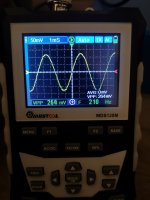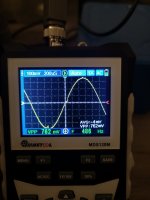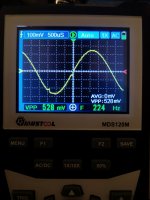Actually you should check for oscillation, if it's present , maybe that capacitor value needs to be changed. But stk no longer produced , so you can expect anything with fakes , i doubt you get not fake from Amazon ,Eb*, ali , or similar unofficial distributors or shops. Also would be helpful to check with sine wave tone and oscilloscope, how your distortion looks. Is it clipping on negative side,or positive ,or something else.
Thank you.Actually you should check for oscillation, if it's present , maybe that capacitor value needs to be changed. But stk no longer produced , so you can expect anything with fakes , i doubt you get not fake from Amazon ,Eb*, ali , or similar unofficial distributors or shops. Also would be helpful to check with sine wave tone and oscilloscope, how your distortion looks. Is it clipping on negative side,or positive ,or something else.
I see that the issue is more evident at low frequencies (and appears when the volume raises above a certain level, i.e. output measured on loudspeakers > 300 mV).
I made some tests inkecting a sine wave with my "poor man" oscilloscope and this is what I see (not sure it is a crossover thing).
Attached some pictures.
Thanks againg for your help.
Alberto
Attachments
Looks strange , but from pictures i see problems in negative side. What happens, if you increase volume even more ? Will you see hard clipping?
Crossover distortion is when output is missing close to center zero, in one picture i see something like that too ,but it may be digital scope artifact. Try to use lower frequency.
Crossover distortion is when output is missing close to center zero, in one picture i see something like that too ,but it may be digital scope artifact. Try to use lower frequency.
No, I do no see hard clipping. Power looks raising up properly. The sine wave keeps sounding distorted (to the human ear). Does this look like an oscillation?Looks strange , but from pictures i see problems in negative side. What happens, if you increase volume even more ? Will you see hard clipping?
Crossover distortion is when output is missing close to center zero, in one picture i see something like that too ,but it may be digital scope artifact. Try to use lower frequency.
I add that there is about 80 mV DC with 0 volume on loudspeaker.
Thanks, Alberto
80mv dc offset should not cause any problem . You are loading with speaker or resistor now ?
As i understand, music playing undistorted till some level , so its not crossover distortion. You would hear distorted music if at very low volume and distortion reduce with volume increase. Did this amplifier have output protection relays ? If yes , you should check signal with scope at stk output ,before relay.
If you have small capacitor like few pf , you can check if its oscillation or not ,but you need to limit power to stk in case it will oscillate .
As i understand, music playing undistorted till some level , so its not crossover distortion. You would hear distorted music if at very low volume and distortion reduce with volume increase. Did this amplifier have output protection relays ? If yes , you should check signal with scope at stk output ,before relay.
If you have small capacitor like few pf , you can check if its oscillation or not ,but you need to limit power to stk in case it will oscillate .
Now I am using 4 ohms speakers and measuring waves from speaker cables. There are not relays; you suggest to remove small capacitors and see if the issue still lives, right?80mv dc offset should not cause any problem . You are loading with speaker or resistor now ?
As i understand, music playing undistorted till some level , so its not crossover distortion. You would hear distorted music if at very low volume and distortion reduce with volume increase. Did this amplifier have output protection relays ? If yes , you should check signal with scope at stk output ,before relay.
If you have small capacitor like few pf , you can check if its oscillation or not ,but you need to limit power to stk in case it will oscillate .
Thanks again for your support.
This issue is driving me crazy....
Alberto
No , no way, don't remove those small capacitors, existing on board. Just try solder on top one pin of lets say 3,3 pf and press with something isolated that capacitor, that it will touch second leg and connect in parralel . Also note which channel you affecting.
But you need to limit power to stk heavily, try to put small power resistors few ohms , somewhere after big capacitors , closer to stk power supply pins , positive and negative, maybe break track or desolder jumper. Maybe 10 or even more ohms. And look at scope, if adding that small capacitor change waveform, but don't increase volume too much ,resistors will smoke.
But you need to limit power to stk heavily, try to put small power resistors few ohms , somewhere after big capacitors , closer to stk power supply pins , positive and negative, maybe break track or desolder jumper. Maybe 10 or even more ohms. And look at scope, if adding that small capacitor change waveform, but don't increase volume too much ,resistors will smoke.
OK, will try.No , no way, don't remove those small capacitors, existing on board. Just try solder on top one pin of lets say 3,3 pf and press with something isolated that capacitor, that it will touch second leg and connect in parralel . Also note which channel you affecting.
But you need to limit power to stk heavily, try to put small power resistors few ohms , somewhere after big capacitors , closer to stk power supply pins , positive and negative, maybe break track or desolder jumper. Maybe 10 or even more ohms. And look at scope, if adding that small capacitor change waveform, but don't increase volume too much ,resistors will smoke.
Thanks,
Alberto
First analyse schematic , typically there are some power supply bypass capacitors near stk . Locate tracks from main capacitors to stk power supply lines and find way how to break direct track and put resistor in series , i would say smallest power you have , 0,25w or 0,125w . Try with one channel only. Turn on power and resistors should not smoke , scope should display the same as before , then while watching scope , connect second leg of capacitor and watch if waveform changes and how . Be prepared to turn off quickly in case of oscillation. Also better replace speaker with resistor at test time.
- Home
- Amplifiers
- Solid State
- Fisher CP-7000 distortion



